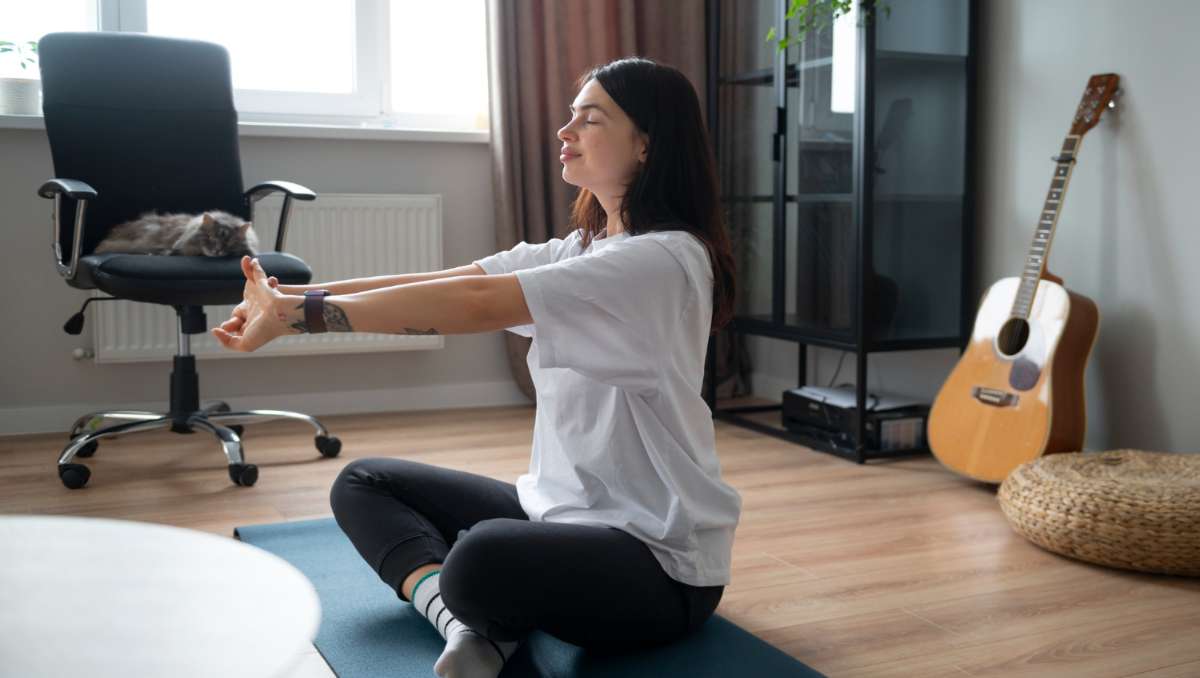Sitting for hours at your desk might be part of the job, but your body wasn’t built for stillness. If your back feels stiff or your legs are begging to move, you’re not alone. Long periods of sitting can leave your body feeling tight and out of alignment. That’s where a few full-body office chair stretches come in. No need to change clothes or leave your workspace; just a few intentional movements to help you feel re-energized and ready to finish the day strong.
Key Takeaways:
- Sitting for long hours can lead to muscle tension, poor posture, and long-term health risks.
- Stretches like seated twists, neck rolls, and leg extensions are quick, effective, and desk-friendly.
- Pair stretching with ergonomic adjustments and light activity for the best results.
In this guide, we’ll walk you through simple, effective stretches you can do without leaving your desk. No awkward moves—just practical relief, one stretch at a time.
Why Movement Matters
It’s easy to underestimate the toll sitting takes on the body, especially when you’re deep in work and hours fly by. But science is clear: prolonged sitting is a serious health risk. Research has linked extended periods of sitting to obesity and a group of conditions known as metabolic syndrome. This includes increased blood pressure, high blood sugar, excess fat around the waist, and abnormal cholesterol levels.
This brings us to a crucial question: Why do we stretch after sitting for a long time? Stretching is vital because it helps to counteract the shortening and tightening of muscles that occur from prolonged inactivity. These small breaks can boost circulation, loosen stiff muscles, and re-energize your mind. As Sonali Dharve from Hip Xpert aptly states:
“From an ergonomic and physiological perspective, the single most crucial benefit of performing full-body stretches from an office chair regularly is the prevention of musculoskeletal imbalances and the promotion of sustained blood circulation.”
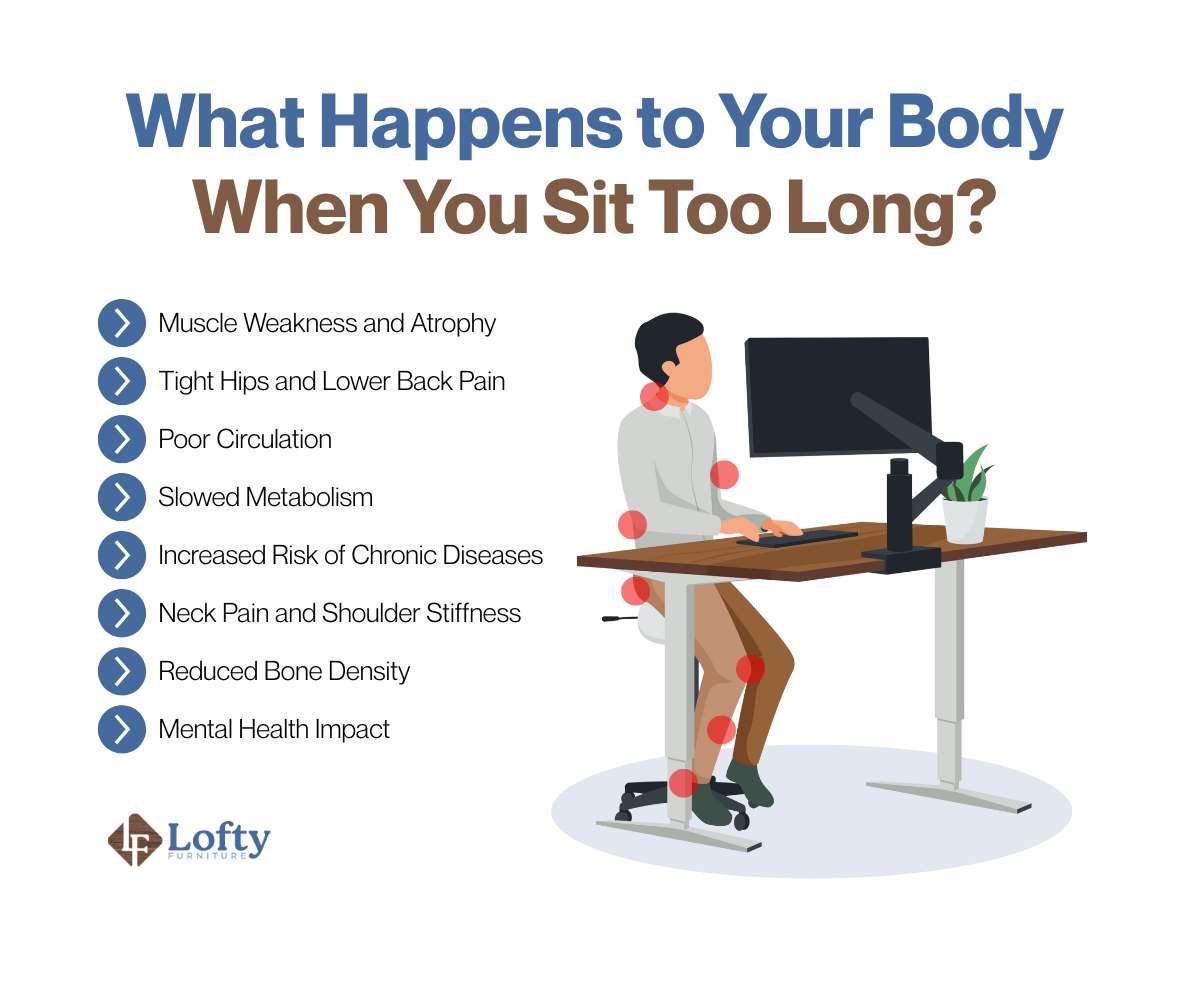
How to Prepare for Office Chair Stretches
The best time to do office chair stretches is every 60 to 90 minutes right before your body starts sending those subtle SOS signals like stiffness or mental fog. These short movement breaks don’t need to derail your workflow; in fact, they’re more effective when they’re regular and low-effort. Before you begin, take a minute to set up your space. Clear the area around your chair so you have room to move your arms and legs freely. Ideally, use a sturdy chair without wheels to avoid slipping or shifting during seated stretches. Most importantly, listen to your body. If you experience sharp pain or dizziness, stop immediately and ease out of the position.
Full-Body Office Chair Stretches to Reset Your Body
Full-body office chair stretches like neck rolls, chest openers, hamstring stretches, shoulder shrugs, spinal twists, and wrist stretches are a simple way to reset your body during the workday. They help release built-up tension, improve your posture, and give you a quick boost of energy—without ever leaving your chair.
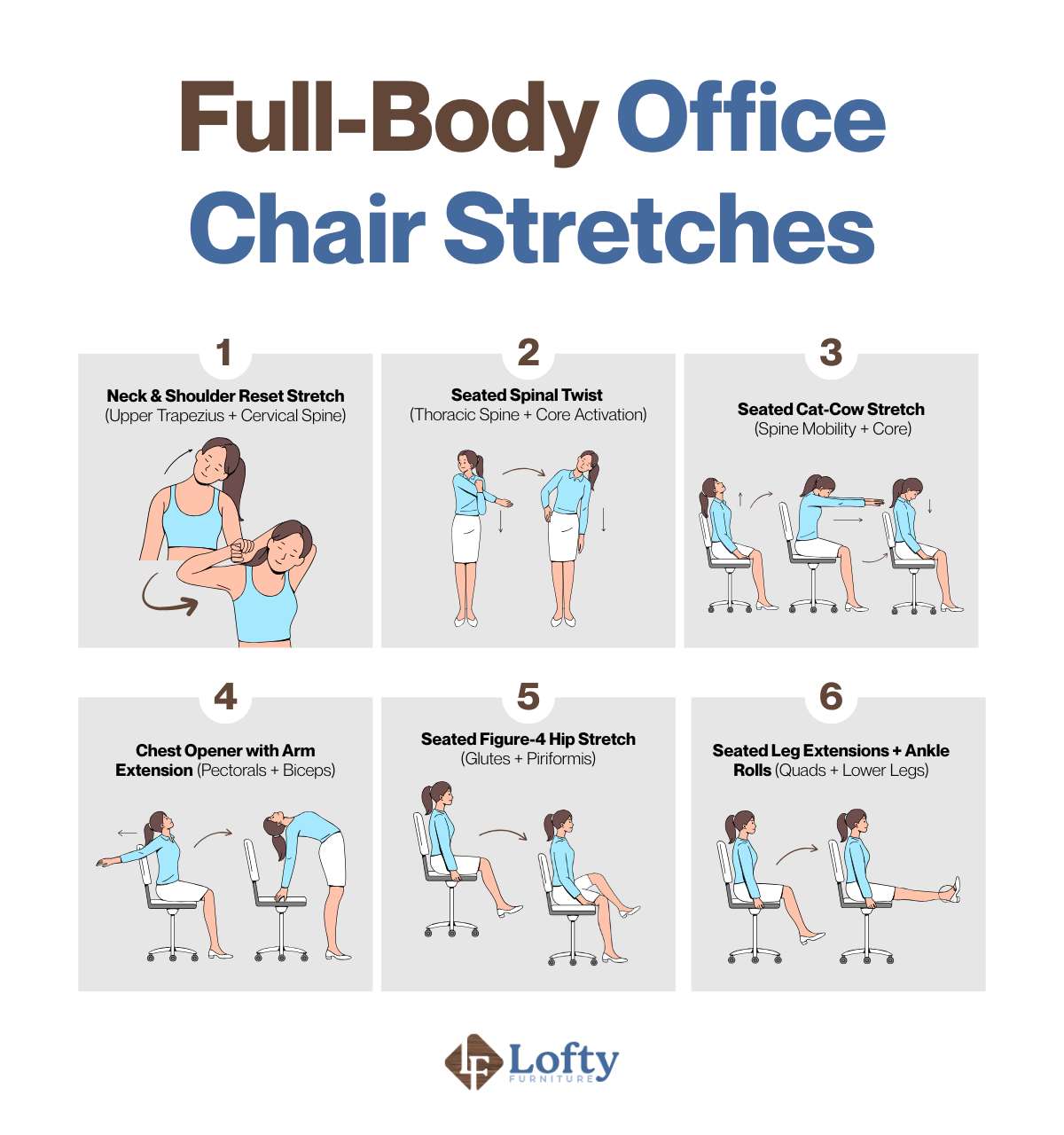
Here’s a closer look at each stretch—what it targets and how to do it:
1. Seated Cat-Cow Stretch (Spine Mobility + Core)
Improves spinal mobility and gently engages your core.
- Sit forward on your chair with your feet flat and hands on your knees.
- Inhale as you arch your back, lifting your chest and chin (Cow).
- Exhale as you round your spine, tucking your chin and pelvis (Cat).
- Continue moving with your breath for 5–8 slow rounds.
2. Neck & Shoulder Reset Stretch (Upper Trapezius + Cervical Spine)
- Sit upright in your chair with both feet flat on the floor.
- Gently tilt your head to the right, bringing your ear toward your shoulder.
- Let your right hand rest on the left side of your head, applying light pressure.
- Hold for 15–30 seconds, breathing deeply.
- Repeat on the opposite side.
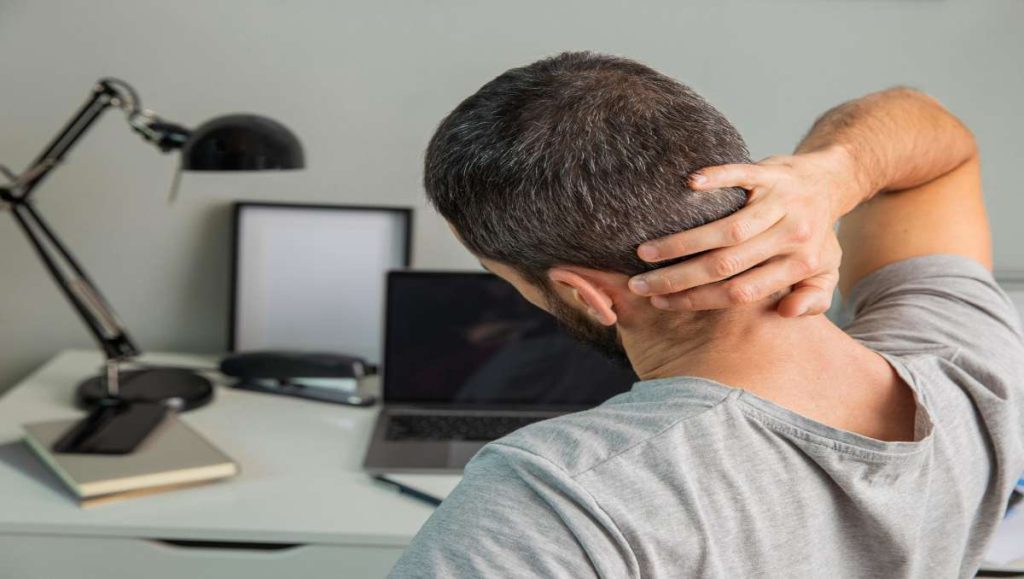
Releases built-up tension in the upper trapezius and lengthens the side of the neck. As Sonali notes:
“Stretch addresses tension in the neck and upper trapezius muscles, which are frequent sites of pain in office workers. This enhances mobility of the neck and can help to minimize headache.”
3. Seated Spinal Twist (Thoracic Spine + Core Activation)
- Sit tall with your feet flat and knees at 90 degrees.
- Place your right hand on the outside of your left thigh.
- Gently twist your torso to the left, using your hand for leverage.
- Look over your left shoulder and hold for 15–20 seconds.
- Return to center and repeat on the other side.
Activates your core and mobilizes the thoracic spine to combat stiffness. According to Sonali:
“This stretch mobilizes the spine, stretches the obliques and back muscles, and can assist in loosening mid-back stiffness commonly caused by extended desk work.”
4. Seated Leg Extensions + Ankle Rolls (Quads + Lower Legs)
Activates your quads and improves circulation in the lower legs.
- Sit upright and extend your right leg straight out in front of you.
- Hold the leg up for 5 seconds to engage the quad.
- Roll your ankle in slow circles—5 in each direction.
- Lower your leg and repeat on the other side.
- Do 2–3 rounds per leg.

5. Chest Opener with Arm Extension (Pectorals + Biceps)
Stretches the chest and biceps—areas that tighten from hunching forward.
- Sit upright and interlace your fingers behind your back (or hold a towel if needed).
- Straighten your arms and gently lift your hands away from your back.
- Open your chest and squeeze your shoulder blades together.
- Hold for 20–30 seconds while breathing deeply.
- Release slowly.
6. Seated Figure-4 Hip Stretch (Glutes + Piriformis)
- Sit tall and place your right ankle over your left knee, forming a “4” shape.
- Flex your right foot and gently press down on your right knee.
- Hinge forward at the hips until you feel a stretch in your right glute.
- Hold for 20–30 seconds, then switch sides.
Targets the glutes and piriformis to release hip pain and tightness. Deepak Shukla, founder of Wellness In Italy, highly recommends this specific movement, stating:
“Glute + hip release that undoes hours of laptop slouching. These take 90 seconds, no sweat, no awkwardness. Just instant blood flow, body awareness, and a much better presence.”
Need a new office chair to make those stretches even more effective? Click here to browse our top-rated ergonomic options and upgrade your workspace today!
Other Ways to Break Up Sitting Time
While chair stretches are a great start, mixing in more full-body movement throughout your day can take things a step further. Try walking meetings, short stair climbs, or simply standing during phone calls. If your workplace allows, use a standing desk for part of the day to shift your posture and engage different muscles. Even five minutes of light walking can reset your circulation and improve focus, especially during long work blocks.
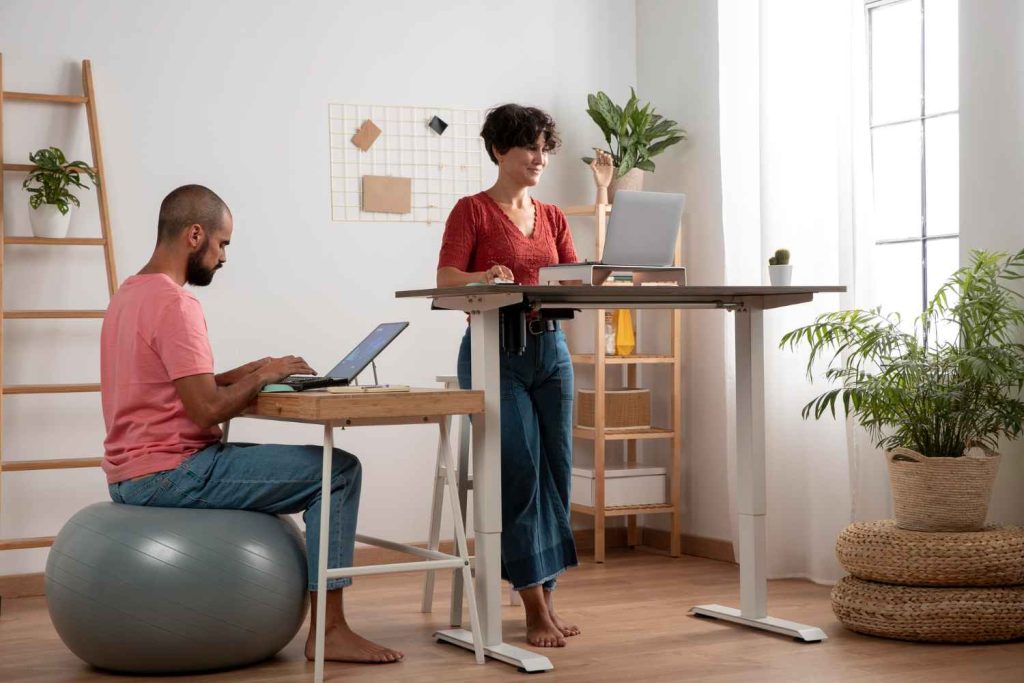
One smart way to stay consistent is by using a Pomodoro timer, traditionally 25 minutes of work followed by a 5-minute break. During those breaks, stretch, walk, or just stand up and breathe deeply. You can also use apps like Stretchly, Stand Up!, or Focus Booster to set gentle reminders for movement. These nudges help build a habit of breaking up sedentary time without disrupting your workflow. As Deepak emphasizes:
“The biggest benefit of full-body office chair stretches is neuromuscular reset. You’re not just loosening tight hips—you’re interrupting static posture patterns that mess with circulation, breathing, and focus.”
Conclusion: Reclaim Your Energy with Simple Seated Stretching
You don’t need a complete lifestyle overhaul to fight the effects of sitting all day, just a little physical activity, done regularly. Office chair stretches offer a low-effort, high-impact way to reset your body, reduce discomfort, and regain focus without leaving your desk. When paired with short walking breaks and mindful posture habits, these micro-movements can help you stay energized, more productive, and less achy by the end of the day. The key is consistency, not complexity.
Frequently Asked Questions
How often should you stretch at your desk?
Ideally, you should stretch or move every 60 minutes—before stiffness sets in. Experts suggest taking 5–10 minute movement breaks each hour to help improve circulation, reduce muscle tension, and prevent posture-related fatigue.
Are office chair stretches enough to combat sitting-related health risks?
They’re a great start, especially for improving circulation and reducing tension, but they work best when combined with other habits like standing breaks, walking, and good posture. Desk stretches should complement, not replace, regular movement throughout the day.
Is it good to stretch every day?
Yes, stretching every day is beneficial. Daily movement that targets each major muscle group can improve flexibility, support better posture, and help reduce stiffness over time.
